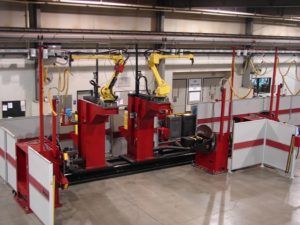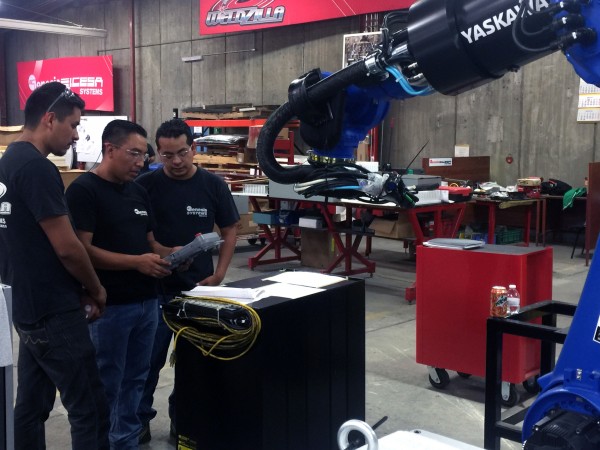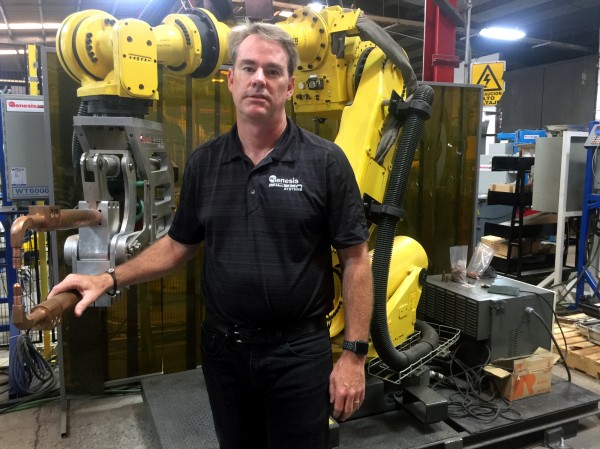
When Donald Trump won the U.S. presidency in November with a promise to lure back manufacturing jobs, Sean Patton trimmed his sales projections for 2017. Patton is head of business development for Genesis-ICESA Systems, a family-run automation integrator based in Mexico’s Bajío region. His company largely caters to the country’s burgeoning automotive industry, a big exporter to the United States.
Midway through 2017, however, it looks as if Mexico’s automotive engine can’t be stalled: the industry is anticipating its eighth consecutive year of record-high production and exports. And in a bid to stay competitive, the Mexican car industry is embracing ever more automation. Genesis-ICESA, which has installed more than 500 robots since its founding in 1974, has seen its bookings double in the first half of 2017 over the number for the first half of 2016, putting the company on track for its best year ever. “It’s going to be a very good year for robotics,” says Patton.
Just as U.S. manufacturers are increasingly turning to robots take on work once done by humans, so too is Mexico heading toward a future of increasingly automated factories. The Boston Consulting Group predicts that Mexico will rely on robots for slightly more than 30 percent of tasks by 2025, versus a current global average of 10 percent. China, Japan, and the U.S. are automating at an even faster pace, with BCG forecasting that those countries might use robots for as many as 45 percent of tasks eight years from now.
Helping Mexico get there will be firms like Genesis-ICESA, which designs and assembles the workstations that automate certain manufacturing tasks. On a sweltering Thursday in June, Patton gave me a tour of his 40,000-square-foot facility, on the grounds of a former tire factory. Fluorescent lights shone on brightly hued machines and metal structures scattered across two immense warehouses—splashes of red, blue, and yellow against drab concrete floors. The sound was cacophonous as metal clinked against metal and air compressed inside a giant press that precisely shaves steel slabs.
Genesis-ICESA employs nearly 100 Mexicans, mostly engineers who design or assemble the workstations known as cells. Inside each cell, one or more robots will perform specific tasks at client factories, such as fastening screws into an auto part. Some stations are self-contained crates that can be shipped whole, while others resemble props in a play that must be restaged.
On this particular day, there’s a contraption with clamps that Genesis-ICESA built to hold Tesla seat supports while a robot fuses the pieces together; a caged-in area where a towering white robot from a company called Nachi welds sun-roof frames for Ford; and an orange lift-assist station that will mount doors for Navistar. With a slight nudge, a heavy-looking lever on the lift assist swings from right to left, like workout equipment without resistance, allowing workers to move 100 pounds with just one pound of force.

AMY GUTHRIE

Mexico is now the sixth-biggest producer of vehicles in the world. The country has two dozen auto production plants, and in recent years it has attracted the majority of new car-factory openings in North America. Genesis-ICESA targets those carmakers’ suppliers, and the lines the firm designs typically stay in Mexico. Most of the products made on those lines will go to the U.S. eventually. Four out of five light vehicles assembled in Mexico today are sold to U.S. consumers.
Genesis-ICESA customers like GeNI, a Mexican auto-parts maker backed by Germany’s GEDIA Automotive Group that stamps out parts for carmakers such as Nissan and Volkswagen, visit the factory for final tests and tweaks before the cells are shipped to their factories.
On the factory floor the day of my visit, GeNI engineer Leopoldo Ortiz looks over a two-tiered work station that Genesis-ICESA designed for his factory in Puebla, a city three hours by car from the Bajío region. In it, a $130,000 welding machine inserts bolts into an aluminum car part. Then the piece is wedged into a $30,000 table to check that all the bolts are properly in place. The workstation is meant to eliminate the margin for human error, says Ortiz:“We need to be more efficient. If you have more people, you have more risk.”
Nearby, three Genesis-ICESA employees are training a cobalt-blue robot made by Yaskawa to trace simple shapes: squares, triangles, and circles. A giant arm retracts and descends. As it draws, the robot emits a shrill sound similar to the whir of a dentist’s drill.
René Sánchez, the 31-year-old engineer leading the Yaskawa through its calisthenics, appreciates that robots can help workers lift heavy objects or weld materials without inhaling harmful fumes. But he’s also wary of their ascent. “The disadvantage is that they eliminate the operator—a lot of people won’t have jobs,” says Sánchez.
Wages in Mexico are low compared with levels in the U.S., where the average auto worker makes more in an hour than a Mexican worker makes in a day. So robots aren’t always the cheapest solution here. In the near term wages are projected to remain low, keeping the country’s sizable manufacturing workforce employed in the coming decade.
A record-high 5.15 million Mexicans worked in manufacturing as of May, nearly a quarter of all workers registered with the country’s social security institute. Around 202,000 Mexicans joined the ranks of manufacturing workers during the first five months of this year alone.
“What I see in Mexico is there’s a balance between automation and manual labor, where you take advantage of both,” says Patton. Grueling and repetitive jobs will get automated, while tasks that require eyes, ears, a sense of touch, and a brain should still be done by humans.
Thirty miles from Genesis-ICESA, down a bucolic road that cuts through farmland and head-high stalks of corn, the Belgian auto-parts maker Bosal has put multiple robot-assisted cells to work. In the past 18 months, Bosal has spent nearly $20 million on automation, much of that with Genesis-ICESA. The automation drive has cut back on Bosal’s local hiring needs, although strong demand for parts has still led the company to increase its Mexican workforce by 50 percent since 2014, says Luis Palomé, regional director for Bosal in Mexico.
The ambient noise on the floor of the Bosal plant in Querétaro is similar to that of a giant washing machine stuck on the spin cycle. Workers place mufflers into a station built by Genesis-ICESA that resembles a small shipping container. They punch buttons on a control panel. A safety curtain descends. Then the robot inside the box does the welding for them. Sparks fly behind a plastic window in the curtain.
Not far away, at a more manual station, workers earn on average $13.50 a day—three times Mexico’s minimum wage—to insert metal tubes into a machine that then bends the tubes. At a Bosal plant in Michigan, the company paid $1 million to introduce a robot that feeds the same type of machine, the job still being done by hand in Mexico. The company amortizes its robotic cells over 10 years. In Mexico, Palomé explains,“it doesn’t justify the cost of a robot.”
That’s good news to Oscar González, a Bosal employee who has been pushing those tubes into a machine for the past year. The job requires teamwork, he says, questioning how a robot would collaborate with the coworkers weaving around him. “We’re not homogenous,” he says.


















